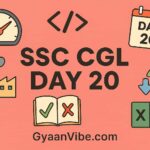GyaanVibe is a focused educational platform dedicated to helping SSC CGL aspirants crack Tier 1 & Tier 2 exam with a strategic, day-wise, and well-structured preparation approach.
SSC CGL Preparation – Day 9
Quantitative Aptitude: Speed, Distance, and Time
🔹 Basic Formulae
- Speed = Distance / Time
- Distance = Speed × Time
- Time = Distance / Speed
Unit Conversion:
- To convert km/hr to m/s → multiply by 5/18
- To convert m/s to km/hr → multiply by 18/5
🔹 Average Speed
- When equal distance is covered at different speeds: $$\text{Average Speed} = \frac{2xy}{x + y}$$ where x and y are the two speeds.
- If total distance and total time are known: $$\text{Average Speed} = \frac{\text{Total Distance}}{\text{Total Time}}$$
🔹 Relative Speed
- Same direction:
Relative speed = |Speed₁ − Speed₂| - Opposite direction:
Relative speed = Speed₁ + Speed₂
🔹 Important Concepts and Shortcuts
- Crossing a Pole
- Time = Length of train / Speed
- Crossing a Platform
- Time = (Length of train + length of platform) / Speed
- Meeting Point (Moving Towards Each Other)
- Time to meet = Distance between / (Sum of speeds)
- Chasing (Same Direction)
- Time = Distance gap / (Relative speed)
- Circular Track Meeting
- If two people run in opposite directions, they meet every: $$\text{Time} = \frac{\text{Total track length}}{\text{Sum of speeds}}$$
- If they run in same direction, they meet every: $$\text{Time} = \frac{\text{Total track length}}{\text{Difference of speeds}}$$
- Upstream and Downstream (Boats and Streams)
- Downstream speed = Boat + Stream
- Upstream speed = Boat − Stream
- Time = Distance / Effective Speed
🔹 Examples
Example 1:
A car travels 180 km in 3 hours. What is its speed?
Solution:
Speed = 180 / 3 = 60 km/hr
Example 2:
A train 300 meters long crosses a pole in 30 seconds. What is the speed in km/hr?
Solution:
Speed = 300 / 30 = 10 m/s = 10 × 18/5 = 36 km/hr
Example 3:
A man walks 20 km at 5 km/hr and returns at 4 km/hr. What is his average speed?
Solution:
Average Speed = (2 × 5 × 4)/(5 + 4) = 40 / 9 = 4.44 km/hr
Example 4:
Two trains of lengths 200 m and 100 m are moving in opposite directions at 60 km/hr and 90 km/hr. Time taken to cross each other?
Solution:
Relative Speed = 60 + 90 = 150 km/hr = 150 × 5/18 = 41.67 m/s
Total distance = 200 + 100 = 300 m
Time = 300 / 41.67 ≈ 7.2 seconds
Example 5 (Boat and Stream):
Boat speed = 15 km/hr, Stream speed = 5 km/hr
Find downstream and upstream speeds.
Solution:
Downstream = 15 + 5 = 20 km/hr
Upstream = 15 − 5 = 10 km/hr
🔹 Tips for SSC CGL
- Questions often involve train crossing, boats & streams, and average speed.
- Convert units before applying formulae.
- Check options for shortcuts (especially approximation).
- Practice relative speed and boat problems thoroughly.




